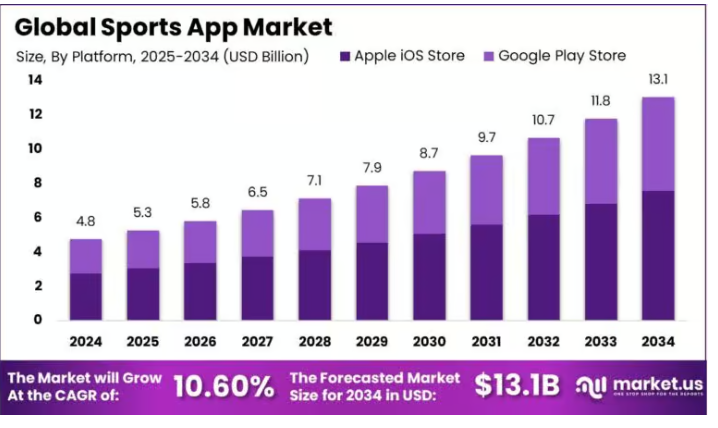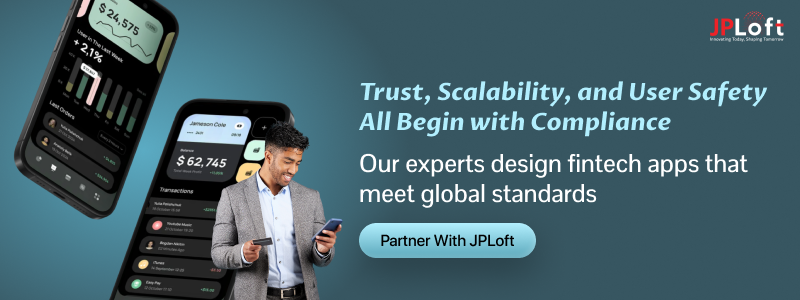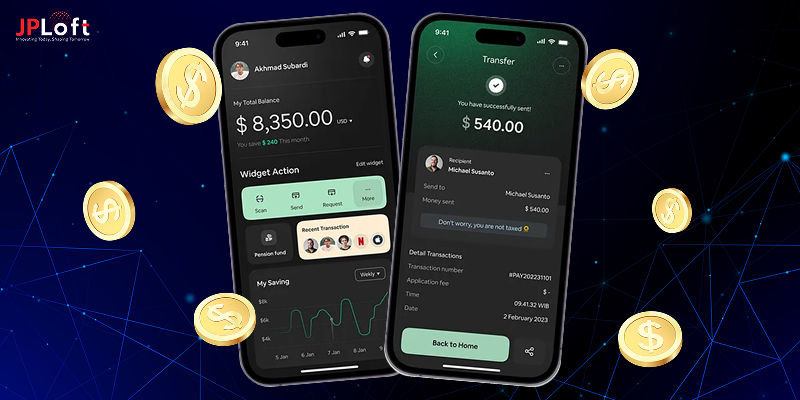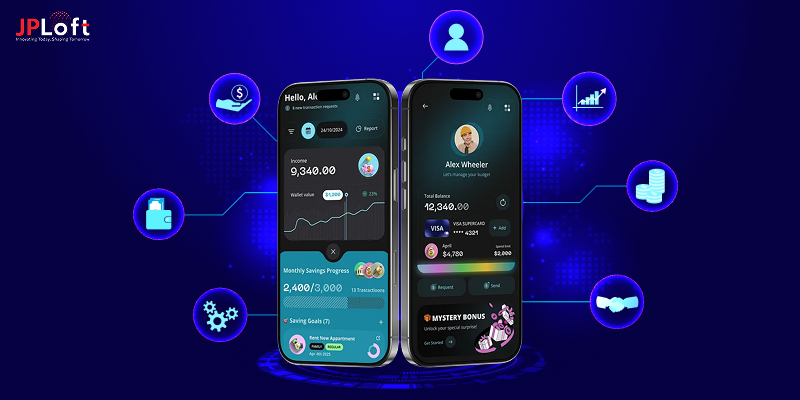Key Takeaways:
Fintech compliance requirements protect user trust, secure financial data, and ensure your app scales safely in regulated markets.
Global regulators like the FCA, SEC, MAS, and other regulators set region-specific rules, making early fintech app compliance planning essential for market entry.
Data privacy, KYC, AML, payment security, licensing, consumer protection, and cybersecurity are the key elements of a strong fintech app compliance checklist.
The challenges in meeting fintech app compliance include strict and fragmented regulations, costly implementation, as well as rapidly changing scenarios.
Meeting data privacy laws such as GDPR and CCPA helps prevent costly breaches and ensures lawful data handling.
KYC, AML, and CTF safeguards reduce fraud and cybercrime by verifying users and monitoring suspicious transactions.
Regular audits, reporting, and cross-border compliance keep fintech apps audit-ready and expansion-ready across global markets.
AI-driven monitoring, stricter data localization, open banking, and crypto regulations are the key future fintech app compliance to be followed.
Fintech App Compliance Guide: Key Regulations, Challenges, and Trends
Fintech is not just an abbreviation, but a much wider term covering diverse industry verticals. From banking to insurance, lending, and other financial services, the sector encompasses everything that involves a monetary element.
The global fintech sector is expected to reach $1.5 trillion by 2030, which is almost a 6x growth from $245 billion currently. Hence, for an entrepreneur, the sector offers a growth opportunity to be focused on.
But the fintech space is not as simple as building an app, making it live, and just chasing downloads. As they deal with sensitive personal and financial information, these apps are required to comply with industry laws and regulations.
Failing to comply with these fintech app regulatory compliances can impact your users’ trust, app scalability, and even result in your app being banned. That’s why building compliance into your fintech app from day one isn’t optional, but is essential.
If you are building your fintech app compliance checklist, then this blog is your ultimate guide, which can help you better understand the compliance requirements for your fintech app.
Why is Financial Compliance Important?
The global fintech space currently has $250 billion in revenue, with the potential to reach up to $13 trillion by leveraging the current and emerging trends. However, while focusing on such trends, the potential threats should also be considered.
As per recent reports, the cyberattacks are increasing by 65% Y-o-Y in the fintech space. Hence, for a sector that deals with money and finances, any loophole can drain users’ wallets.
These are not just the data that statisticians use to prepare annual reports. But these statistics also indicate the need for strong fintech compliance requirements.
These compliances bind the fintech firms to take strict measures to protect users’ personal and financial information.
However, these regulations and compliances for fintech apps can vary across regions or countries. Hence, the fintech firms need to focus on specific compliances that apply to their fintech app and implement it accordingly.
Revenue Distribution of Top Fintech Segments:

Major Fintech Regulators Across The World
A single entity rarely handles fintech compliance requirements across the global fintech space. Rather than that, jurisdiction-wise agencies and regulators exist that govern the financial sector and activities, depending on their legal, economic, and institutional setup.
Hence, depending on the region or jurisdiction you are planning to launch or expand your fintech app, you need to be aware of the regulatory authorities. Such can plan your fintech app features that can support your mobile app security and scalability.
Let’s focus on the major fintech regulators that you must be aware of.
|
Country |
Regulatory Body/Authority |
Role in Managing Fintech Compliance |
|
Global |
International Organization for Standardization (ISO) |
Publishes global standards like ISO/IEC 27001, which fintechs adapt to prove data security, privacy, and operational resilience. |
|
International Telecommunication Union (ITU) |
Defines digital communication standards that underpin secure mobile payments, cross-border transfers, and app interoperability. |
|
|
Financial Action Task Force (FATF) |
Sets international benchmarks for Anti-Money Laundering (AML) and Counter-Terrorist Financing (CTF). Local regulators align fintech rules with FATF guidance. |
|
|
United States |
Securities and Exchange Commission (SEC) |
Regulates securities and investment products offered via fintech apps, including robo-advisors, crowdfunding platforms, and tokenized assets. |
|
Commodity Futures Trading Commission (CFTC) |
Oversees futures, derivatives, and parts of the digital asset market relevant to fintech platforms. |
|
|
Consumer Financial Protection Bureau (CFPB) |
Protects consumers using digital lending, credit scoring, and payments apps by enforcing fair practices. |
|
|
Office of the Comptroller of the Currency (OCC) |
Supervises national banks and issues special fintech charters for digital-only banking services. |
|
|
State-Level Regulators |
Each state manages specific licenses such as money transmission and crypto activity (e.g., New York’s BitLicense). |
|
|
Canada |
Canadian Securities Administrators (CSA) |
Coordinates the regulation of securities and fintech trading platforms across provinces. |
|
Financial Consumer Agency of Canada (FCAC) |
Ensures transparency and fairness in digital financial products and services. |
|
|
Office of the Superintendent of Financial Institutions (OSFI) |
Oversees banks and large financial institutions, including fintech partnerships with them. |
|
|
European Union |
European Banking Authority (EBA) |
Develops EU-wide banking and payments standards, including PSD2 rules for open banking APIs. |
|
European Securities and Markets Authority (ESMA) |
Oversees investment products and fintech platforms that deal with securities. |
|
|
National Regulators (per member state) |
Each EU country enforces fintech regulation locally (e.g., BaFin in Germany, AMF in France) under EU directives. |
|
|
United Kingdom |
Financial Conduct Authority (FCA) |
Regulates fintech firms across payments, lending, crypto, and securities. Known for running one of the first fintech regulatory sandboxes. |
|
China |
People’s Bank of China (PBOC) |
Supervises banks, payment providers, and digital wallets. Regulates mobile payments and fintech innovations like digital yuan. |
|
China Securities Regulatory Commission (CSRC) |
Governs securities trading, including fintech platforms offering investment services. |
|
|
India |
Reserve Bank of India (RBI) |
Regulates banks, digital lending, payment aggregators, and fintech payment systems. |
|
Securities and Exchange Board of India (SEBI) |
Oversees fintech platforms offering trading, mutual funds, or investment services. |
|
|
Japan |
Financial Services Agency (FSA) |
Single regulator for banks, securities, insurance, and fintech innovations, including crypto exchanges. |
|
South Africa |
South African Reserve Bank (SARB) |
Maintains financial stability and supervises payment systems used by fintech apps. |
|
Financial Sector Conduct Authority (FSCA) |
Oversees financial service providers, including fintech platforms in lending and investments. |
|
|
United Arab Emirates |
Central Bank of the UAE (CBUAE) |
Supervises banking, payments, and fintech financial institutions. |
|
Securities and Commodities Authority (SCA) |
Regulates securities markets and fintechs offering investment services. |
|
|
Financial Services Regulatory Authority (FSRA – Abu Dhabi Global Market) |
Special authority within ADGM that regulates fintech innovation, including digital assets and blockchain startups. |
|
|
Saudi Arabia |
Saudi Arabian Monetary Authority (SAMA) |
Regulates banks, insurers, and payments, and licenses fintech operators. |
|
Capital Markets Authority (CMA Saudi Arabia) |
Oversees securities trading, crowdfunding, and fintech investment firms. |
Fintech App Compliance Checklist To Be Followed
Fintech App Regulatory Compliance plays an essential role in the success and scalability of your fintech app.
Hence, rather than making assumptions, it is better to plan for a detailed fintech app compliance checklist that can guide you and your developers on what to follow and what not.
Let’s focus on a practical checklist that every fintech startup or firm should focus on.
1. Data Privacy and Protection
Fintech apps deal with sensitive information like bank details, IDs, and personal addresses. Hence, check for the compliance for fintech apps around the world on how you collect, store, and use this data.
► Global Standards
The GDPR in Europe requires apps to ask for clear consent, only collect what they need, and give users the option to delete or export their data. In the US, the CCPA and GLBA regulate financial data privacy. Other examples include Brazil’s LGPD and Singapore’s PDPA.
► Technical Safeguards
You must use strong encryption, secure servers, and strict access controls. GDPR also requires “privacy by design,” which means you must build privacy protection into your app from the very beginning.
► Compliance Consequences
Focus on the compliance consequences, as breaking privacy rules can cost millions. GDPR fines can reach 20 million euros, or 4% of annual global revenue, as well as impact users’ trust.
2. Know Your Customer (KYC)
KYC rules make sure that only real, verified people use your app. This protects against fraud and illegal activities.
► Regulatory Frameworks
Check for nation-specific frameworks. In the US, KYC is enforced by FinCEN under the Bank Secrecy Act. In the EU, AMLD5 and AMLD6 cover customer verification. Countries like India and Singapore have their own KYC laws.
► Implementation Practices
Most fintech apps ask for a government ID, then match it with a selfie or biometric scan. For high-risk accounts, you may also need to check extra documents like proof of income or business ownership. Many companies use third-party verification services to speed up the process.
► Ongoing Monitoring
KYC isn’t just one step during sign-up. You must keep monitoring accounts for changes. If a low-risk user suddenly starts moving large sums of money, you may need to re-verify them.
3. Anti-Money Laundering (AML) and Counter-Terrorism Financing (CTF)
AML and CTF rules focus on stopping criminals from using your app to hide or move money illegally.
► International Standards
The Financial Action Task Force (FATF) sets global standards for AML and CTF. Countries then enforce them through local regulators like the FCA in the UK, AUSTRAC in Australia, and FinCEN in the US.
► System Controls
Your app must monitor transactions in real time. Look for suspicious behavior, like splitting large sums into smaller amounts to avoid detection (known as smurfing). You also need to screen users against international watchlists of banned individuals or organizations.
► Reporting Obligations
If you find something suspicious, you must report it to regulators. In the US, this means filing a Suspicious Activity Report (SAR). Failing to do so can result in fines or even losing your license.
4. Payment Compliance
Your fintech app compliance checklist must include payment rules that protect both users and banks. If your app handles payments, compliance is not optional.
► PCI DSS Standards
If your app accepts credit or debit cards, you must follow PCI DSS v4.0. This standard covers how to encrypt payment data, control who can access it, and test your system for weaknesses.
► Regional Payment Directives
Europe’s PSD2 law requires strong customer authentication and secure APIs for open banking. In the US, NACHA rules govern ACH payments. Each region has its own rules, so you must adjust based on where you operate.
► Business Continuity Impact
If you don’t comply, card networks like Visa and Mastercard can cut you off. Without access to payment rails, your app cannot function.
5. Licensing and Registration
You need the right license to operate a fintech app. The requirements depend on your target market, where you are planning to launch your fintech mobile app idea.
► Regional Licensing Bodies
In the UK, the FCA gives licenses to electronic money institutions. In Singapore, it’s the MAS under the Payment Services Act. In India, the RBI regulates fintechs, and in the US, you may need licenses in multiple states plus oversight from the SEC or CFTC.
► Ongoing Compliance
A license is not permanent. You must file reports, renew on time, and sometimes maintain minimum capital levels. If you miss these steps, regulators can suspend or cancel your license.
► Scaling Across Borders
When you scale into new countries, you must start with the licensing process again. Each regulator has its own fintech compliance requirements, and approval often takes months or years.
6. Consumer Protection
Customers expect fairness and honesty from any financial service. Regulators make sure fintechs treat users with respect and transparency.
► Regulatory Expectations
In the UK, the FCA has Consumer Duty rules. In the US, the CFPB enforces consumer protection. In the EU, the EBA requires clear communication of fees and terms.
► Operational Requirements
Your app must show fees clearly, explain terms in plain language, and give customers a way to resolve disputes. A strong customer support team is also part of compliance.
► Reputation Risks
If customers feel cheated, they’ll leave your app, and regulators may step in. Robinhood’s troubles in the US are a good example of how poor consumer protection can hurt a fintech brand.
7. Cybersecurity Framework
Fintech apps are commonly the targets of hackers and cybercriminals. That’s why regulators expect strong cybersecurity controls.
► Standards and Frameworks
Many fintechs follow ISO 27001 or the NIST Cybersecurity Framework. The EU enforces ICT security rules, and Australia has APRA CPS 234 for financial services. Also, frameworks are being established to promote AI in cybersecurity.
► Required Safety Measures
You need tools for 24/7 monitoring, systems that detect intrusions, and regular penetration tests. Having an incident response plan is critical, so your team knows exactly what to do if a breach happens.
► Breach Notifications
Under GDPR, you must report a data breach within 72 hours. Similar requirements exist in the US and other countries.
8. Audits and Reporting
Your fintech app should comply with the audit and reporting guidelines. Regulators look for evidence that your app follows the compliance for fintech apps. Hence, reporting is the only way to prove that such compliances are being followed.
► External Audits
Some regulators require annual third-party audits, like MAS in Singapore, for AML compliance. The FCA in the UK also expects routine compliance reports.
► Internal Audit Practices
You should run your own audits regularly. Keep logs of customer data handling, security checks, and compliance reviews. This helps you stay ready for external reviews.
► Reports to Regulators
You’ll often need to file regular reports. These can cover suspicious transactions, risk assessments, or customer complaints.
9. Cross-Border Compliance
Growing across borders brings new challenges. Each transaction may be checked by regulators in more than one country to ensure your app aligns with the fintech compliance requirements.
► International Standards
The FATF sets worldwide AML and CTF rules. In Europe, SEPA rules apply to cross-border payments. The US has its own requirements through FinCEN.
► Risks of Non-Compliance
The sending and receiving countries often have different rules. Some countries also have strict limits on how money enters or leaves.
► Risks of Non-Compliance
If you don’t follow the rules, your payments may be blocked, your accounts frozen, or your business banned from global banking networks.
10. Data Localization Laws
Data localization is becoming a major compliance hurdle as more countries demand onshore storage of sensitive financial data.
► Regional Mandates
Russia enforces data localization for all personal data. China’s Cybersecurity Law mandates that critical data infrastructure remain onshore.
► System Design Implications
Firms must architect their platforms for data residency flexibility, often relying on regional cloud providers or building local data centers. This adds both cost and technical complexity.
► Compliance Risk
Non-compliance isn’t just about fines, but also regulators can deny market access entirely. For fintechs, this makes data localization a market entry barrier, not just a fintech app compliance checklist formality.
How To Build A Compliant Fintech App?
The above-mentioned compliances are significantly important for the success and scalability of any fintech app in the evolving marketplace.
But these compliances are not meant to be a task after the completion of your fintech mobile app development process. These compliances must be planned from day one and implemented in a step-by-step manner to build a secure and compliant Fintech app.
Step 1: Define Your Regulatory Scope
Start by defining your regulatory scope, i.e., check for applicable norms for payments, brokerage, lending, robo-advisory, wallets, or other fintech segments.
Also, list out the markets you are targeting and the regulators controlling the marketplace. Identify licenses or registrations needed to launch your fintech app.
Step 2: Do a Data Inventory and DPIA/PIA
Run a Data Protection Impact Assessment and identify lawful bases for processing. Catalog every data element you collect: PII, KYC docs, financial data, device IDs, telemetry.
Such can help you plan for better data management and user protection when they are using your platform.
Step 3: Embed Privacy and Security In Your App Design
When you plan to build a compliant fintech app, ensure that users’ privacy and security protocols have been implemented. Focus on collecting only the data essential for your app operations.
Adopt relevant encryptions and build consent and preference management into the fintech mobile app design.
Step 4: Implement KYC, AML, and Fraud Controls
To create a compliant fintech app, choose reliable KYC providers, invest in a credible background verification system, to add ongoing sanctions and PEP screening. Along with all, monitor transactions for anomalies and set risk-based thresholds and escalation playbooks.
Focus on relevant API integrations that can perform KYC, as well as indicate in case of any fraudulent activities.
Step 5: Pick the Right Controls Framework
Align your fintech app with a single controls framework like ISO 27001 or SOC 2 to avoid duplicate efforts. From there, add specific layers such as PCI DSS for card data, PSD2 for open banking, and local data protection laws to cover regional compliance needs.
Step 6: Build Operational Governance
When planning to make a compliant fintech app, define RACI and appoint a compliance and security owner. Also, write down the policies that people are expected to follow.
Such can include defining how to opt for a change, vendor risk management, SDLC logging, data backups, and more.
Step 7: Test and Monitor Results Continuously
Conduct security and compliance testing, both pre-and post-launch. Measure MTTD/MTTR and maintain an audit template that can guide and validate each test result.
Such mobile app testing is significantly important to ensure that every API and compliance integration done to your fintech app is performing well and as per the regulatory standards.
Step 8: Vendor and Partner Risk Management
Perform due diligence on every service provider. Such can include attestations, locations, sub-processors, breach history, and SLAs.
Also, plan contracts for data-processing terms, breach notification windows, and the right to audit.
Common Fintech App Compliance Challenges
Building a fintech platform in the current market scenario can bring great entrepreneurial opportunities. But even the most innovative and thoroughly planned fintech apps face challenges in fintech app compliance.
The regulations in the fintech sector are complex, constantly evolving, and vary widely across regions.
Here are some of the most common fintech app compliance challenges:
A] Fragmented Regulations Across Markets
Scaling fintech globally means juggling between fintech app regulatory compliance, as they differ between nations. What works smoothly in the US under SEC or CFPB oversight may not meet EU standards under PSD2 or GDPR.
Solution: Build a regulatory map for each market, work with local legal partners, and keep your regulatory compliance constantly updated as per changing regulations.
B] Data Privacy and Protection
Fintech apps handle highly sensitive personal and financial data. In such a scenario, meeting strict requirements like GDPR, CCPA, or the targeted nation’s data protection law is both resource-heavy and technically demanding.
Solution: Collect the data only what’s essential, encrypt everything, and give users clear control over their data.
C] KYC and AML Compliance
Onboarding users quickly while meeting Know Your Customer (KYC) and Anti-Money Laundering (AML) obligations is tricky. Slow checks frustrate users, but weak checks expose firms to fraud and fines.
Solution: Rely on trusted KYC tools integration, balance speed with accuracy, and set up alerts for suspicious activity.
D] Evolving Fraud and Cyber Threats
Fintechs are prime targets for fraudsters and cybercrime. Keeping up with phishing, account takeovers, and money laundering schemes requires constant monitoring and advanced detection systems.
Solution: Ensure multifactor authentication in your fintech app, monitor activity in real time, and test systems often.
E] Cost of Compliance
Implementing robust compliance programs when you plan to build a compliant fintech app turns out to be expensive for startups and fintech apps with a limited number of users. Also, hiring legal experts, investing in security tools, and running audits stretch early-stage budgets.
Solution: Plan early, assign a compliance lead, and use third-party platforms to reduce overhead. Start with the basics and then shift to expensive upgrades in tools and human resources.
F] Third-Party Risk
Fintech apps often rely on partners and third-party APIs such as payment gateways, cloud providers, or KYC vendors. If these partners fail compliance checks, liability still falls on the fintech.
Solution: Check for their certifications, sign strict data agreements, and monitor the performance of these third-party platforms before integrating them into your app.
G] Record Keeping and Audits
The fintech apps are required to maintain records, such as log changes, access, test, and incident. These are to be submitted to the regulators to prove your fintech app is secure and compliant. However, keeping such records eats up storage, and their encryption is a key challenge.
Solution: Invest in highly secured cloud storage, maintain audit logs, and update them regulatory to identify any security gaps or unauthorized access.
H] Platform Rules
Along with the local regulations and compliance, even the app store has its own rules. When you publish your app on the Play Store or submit your app to the App Store, it needs to align with the platform rules; otherwise, it can get delisted or banned.
Solution: Review their fintech app policies before launch and adjust your app flows and copy.
Future Trends in Fintech Compliance
Fintech app compliance is not stable, and as technology advances and fintech apps expand, these compliances also evolve to keep up with the pace.
Here are the key trends that are shaping the future of fintech compliance.
1. Stricter data protection laws
More countries are focusing on data privacy acts similar to GDPR, and the existing ones are strengthening these laws. Such is being done to protect the user’s interest and to overcome the threat to the user’s privacy and data from cyberattackers.
Fintechs will need to manage local storage rules, stronger consent practices, and real-time breach reporting.
2. Real-time monitoring and AI tools
AI in fintech is expected to take center stage, and even the regulators are encouraging firms to use AI for fraud detection, transaction screening, and suspicious activity alerts.
The fintech compliance strategies are shifting from after-the-fact checks to live monitoring, powered by AI tools and other relevant technologies. Hence, you should connect with an experienced AI app development company.
3. Global push for open banking
Another trend to be focused on when planning a fintech app compliance checklist is open or cross-border banking. These approaches assist in the scalability and growth of the fintech platform.
Also, open banking standards like PSD2 in Europe are inspiring similar models worldwide. Fintechs will have to adopt secure APIs and meet stronger authentication demands.
4. Focus on crypto and digital assets
Fintech users are effortlessly shifting toward and adopting crypto and other digital assets as their regular payment modes and approaches. Hence, following such a trend, the fintech apps are also required to focus on this direction.
Along with such, the governments are setting clearer rules for crypto exchange trends, stablecoins, and tokenized assets. Fintechs touching digital currencies will face tighter licensing and reporting requirements.
5. Emphasis on ESG and ethical finance
ESG is becoming a focus area in the fintech space, and some regulators are starting to look at environmental, social, and governance (ESG) factors in compliance.
Fintechs may need to show fair lending practices and transparent sustainability reporting.
How JPLoft Can Help With a Secure and Compliant Fintech App?
The growth and scalability of a fintech platform rely on the user’s trust, and the app security and compliances defines and shape such trust. Hence, it is important to partner with an expert who better understands both the development and regulatory requirements of a Fintech app.
Hence, all such needs and expectations of yours are fulfilled at JPLoft, the best fintech app development company. We help you plan, build, and launch with security from day one, along with setting up strong encryption for data in transit and at rest.
We also integrate multi-factor login and session controls to stop account takeovers. We follow least privilege, so only the right people and services can access data.
With us, you can ensure that your system is designed to meet rules like PCI DSS for payments, GDPR for privacy, and local banking laws. We document controls, map data flows, and keep audit logs so you can pass reviews with ease.
Partnering with JPLoft can help you get clear reports, secure APIs, and a build plan that fits your team. With JPLoft, your app stays safe, compliant, and ready to earn user trust.
Conclusion
Building a fintech app in 2025 means following the fintech app compliance checklist at the core. Users trust you with their money and data, and regulators expect strict checks on privacy, payments, licensing, and security.
A clear fintech app compliance checklist helps you meet these requirements and avoid costly mistakes. Yes, compliance can feel complex, but when planned early, it becomes a growth enabler, not a hurdle.
At JPLoft, we design fintech apps that meet global standards, protect users, and pass audits with ease. Start secure, stay compliant, and scale with confidence.
FAQs
Fintech app compliance guides and controls the working of a fintech app and protects users’ interests. These compliances ensure that the fintech app meets the legal, security, and regulatory standards across the global market.
Fintech companies are regulated by authorities based on the region or the country you are planning to operate. At a common there are international organizations like ISO and ITU, SEC in the USA, and FCA in the UK.
Building a compliant fintech app requires you to focus on compliance and regulations from day one. Check for the applicable regulations, prepare your checklist, implement every required security tool, and ensure proper testing and reporting throughout the development phase.
The key challenges associated with following fintech app compliance include strict implementation, fragmented regulations across nations, evolving cyber threat issues, third-party threats, record-keeping challenges, and more.
The key trends to be focused on include stricter compliance, increasing use of AI for data monitoring, crypto, and digital asset-related compliance, and more emphasis on ESG and sustainability in the fintech space.













Share this blog